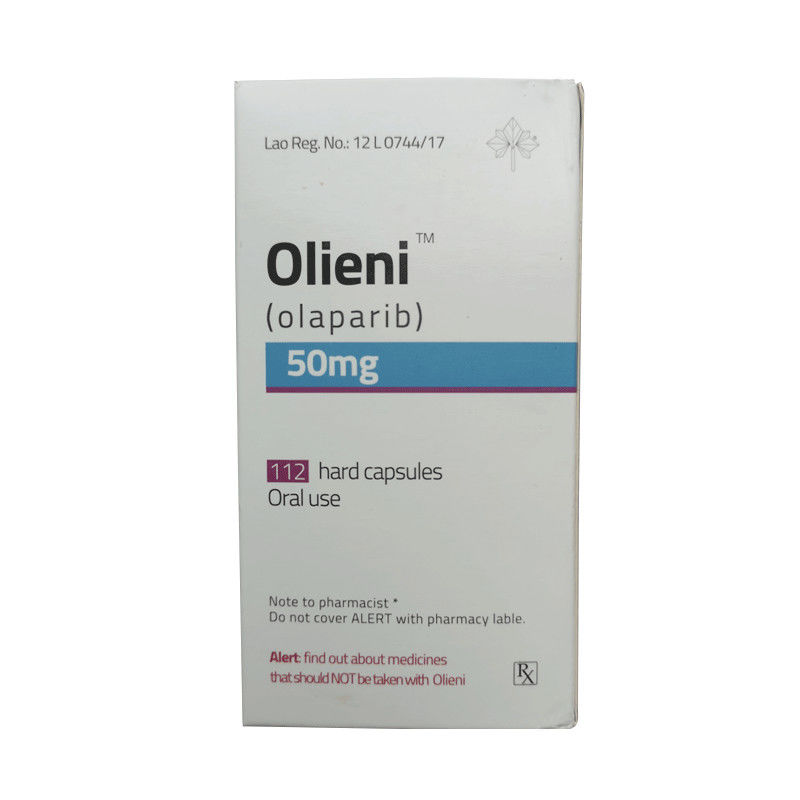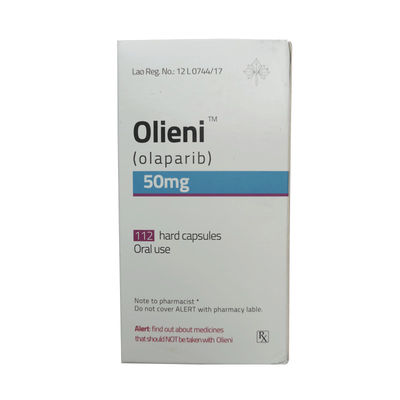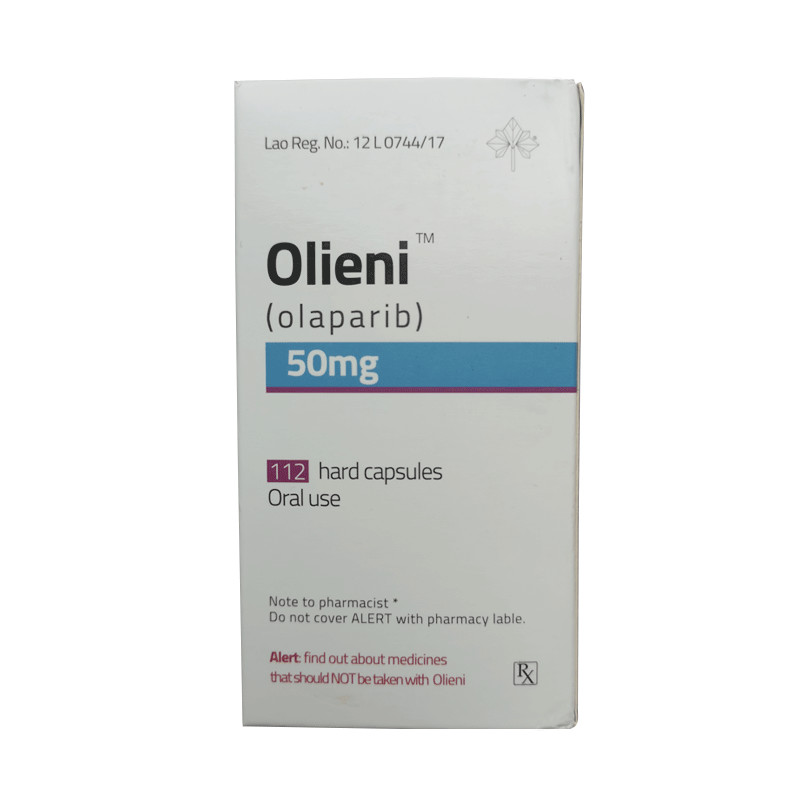【Drug Name】
Generic Name: Lynparza Tablets
Product name: LYNPARZA®/LYNPARZA®
English name: Olaparib Tablets
Chinese Pinyin: Aolapali Pian
【Indications】
This product is suitable for:
Maintenance therapy for treatment-naïve adult patients with advanced epithelial ovarian, fallopian tube, or primary peritoneal cancer who harbor a germline or somatic BRCA mutation (gBRCAm or sBRCAm) after achieving a complete or partial response to first-line platinum-containing chemotherapy.
Maintenance treatment of adult patients with platinum-sensitive recurrent epithelial ovarian, fallopian tube, or primary peritoneal cancer who have achieved complete or partial response to platinum-containing chemotherapy.
Adult patients with metastatic castration-resistant prostate cancer who carry a germline or somatic BRCA mutation (gBRCAm or sBRCAm) and have failed prior therapy, including a novel endocrine agent.
This indication was granted conditional approval based on an analysis of subjects with BRCA-mutated metastatic castration-resistant prostate cancer who had failed prior therapy in the PROfound clinical study. Full approval of this indication will depend on subsequent clinical trials to confirm the clinical benefit of this product in the Chinese population (see instructions [Clinical Trials])
【Dosage】
This product should be used under the guidance of doctors experienced in the use of anti-tumor drugs.
BRCA1/2 mutation testing results from blood and/or tumor samples obtained from local or central laboratories have been used in different studies. BRCA1/2 mutations have been classified as deleterious/suspected to be deleterious or pathogenic/possibly pathogenic, depending on the assay used and international classification consensus.
Before olaparib can be used as first-line maintenance treatment for epithelial ovarian cancer, fallopian tube cancer or primary peritoneal cancer, the presence of germline and/or somatic cells in the patient must be confirmed using testing methods approved by the State Food and Drug Administration or other validated methods. BRCA1/2 mutations.
BRCA1/2 mutation testing is not required prior to maintenance therapy with olaparib in patients with recurrent epithelial ovarian, fallopian tube, or primary peritoneal cancer who have achieved a complete or partial response to platinum-containing chemotherapy.
Before olaparib can be used in metastatic castration-resistant prostate cancer, the patient must be confirmed to have germline and/or somatic BRCA1/2 mutations using testing methods approved by the National Food and Drug Administration or other validated methods.
Recommended dosage
This product is available in 150mg and 100mg strengths.
The recommended dose is 300 mg (2 150 mg tablets) twice daily, equivalent to a total daily dose of 600 mg. 100mg tablets are for use in dose reductions.
Patients should begin treatment with this product within 8 weeks of completion of platinum-containing chemotherapy.
Dosing method
Oral administration. The tablet should be swallowed whole and should not be chewed, crushed, dissolved or broken. This product can be taken with a meal or on an empty stomach.
Miss a dose
If the patient misses a dose, he or she should take the next dose as scheduled.
Dosage adjustment
To manage adverse events, such as nausea, vomiting, diarrhea, anemia, etc., treatment interruption or dose reduction may be considered.
If dose reduction is necessary, the recommended dose is reduced to 250 mg (1 150 mg tablet, 1 100 mg tablet) taken twice daily (equivalent to a total daily dose of 500 mg).
If further reduction is necessary, the recommended dose is reduced to 200 mg (2 100 mg tablets) taken twice daily (equivalent to a total daily dose of 400 mg).
Medication for special populations
renal impairment
Patients with mild renal impairment (creatinine clearance 51-80 mL/min) can use this product without dose adjustment; for patients with moderate renal impairment (creatinine clearance 31-50 mL/min), this product The recommended dose is 200 mg (2 100 mg tablets) twice daily (equivalent to a total daily dose of 400 mg); this product is not available for patients with severe renal impairment or end-stage renal disease (creatinine clearance ≤ 30 mL /min) safety and pharmacokinetic data, the use of this product is not recommended (see the instructions [Pharmacokinetics]).
liver damage
Patients with mild or moderate hepatic impairment (Child-Pugh class A or B) can use this product without dose adjustment (see Insert [Pharmacokinetics]). There are no safety and pharmacokinetic data on this product in patients with severe hepatic impairment (Child-Pugh class C), and its use is not recommended (see the package insert [Pharmacokinetics]).
child or teen
The safety and efficacy of this product in children and adolescents have not been established, and use in pediatric patients is not recommended.
Elderly (>65 years old)
No starting dose adjustment is required in elderly patients. Clinical data are limited in patients 75 years and older.
【Adverse reactions】
Adverse reactions resulting from treatment with olaparib are generally mild or moderate (CTCAE grade 1 or 2) and do not usually require discontinuation of treatment. In various clinical trials, the most common adverse reactions (≥10%) in patients receiving olaparib monotherapy were nausea, fatigue, anemia, vomiting, diarrhea, decreased appetite, headache, dysgeusia, cough, and neutropenia. Cytopenia, dyspnea, dizziness, dyspepsia, leukopenia, and thrombocytopenia. Grade ≥3 adverse reactions occurring in >2% of patients were anemia (16%), neutropenia (5%), fatigue/asthenia (5%), leukopenia (3%), and thrombocytopenia (3 %). The most common adverse reactions leading to discontinuation of monotherapy and/or dose reduction were anemia (16.7%), vomiting (6.3%), nausea (6.2%), fatigue/asthenia (6.1%), and neutropenia (6.0 %). The most common adverse reactions leading to permanent discontinuation of treatment were anemia (1.7%), thrombocytopenia (0.8%), fatigue/asthenia (0.7%), and nausea (0.7%).
【Storage】
Store below 30℃.


 Your message must be between 20-3,000 characters!
Your message must be between 20-3,000 characters! Please check your E-mail!
Please check your E-mail!  Your message must be between 20-3,000 characters!
Your message must be between 20-3,000 characters! Please check your E-mail!
Please check your E-mail! 



